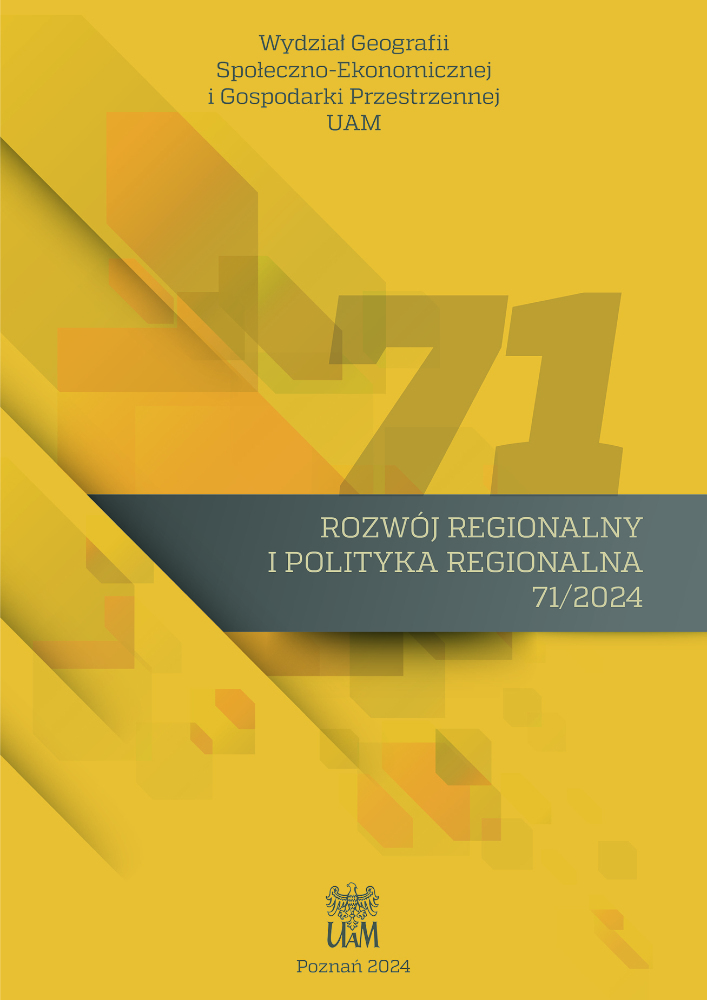Abstract
Increasing urbanization and the growing population of large cities are causing more and more problems related to traffic (traffic jams, accidents, lack of parking spaces, etc.) and environmental degradation. For many cities around the world, micromobility (lightweight vehicles powered by electricity or the power of one’s own muscles, such as bicycles or scooters) is becoming a recipe for the problems of first and last miles, traffic jams and gas emissions. These devices are becoming increasingly popular and widely available, especially as part of the fast-growing sharing economy. However, their emergence in public spaces is also causing problems and challenges for local communities and authorities. Inadequate urban infrastructure, combined with weak enforcement of regulations, causes users of micromobile vehicles to drive into public spaces, overcrowding them and causing serious safety concerns for both themselves and pedestrians. The main purpose of the article is to answer the question of how and to what extent the development of micromobility in cities affects the health and safety of people in public spaces, and whether it contributes to generating conflicts over this space. The basis for the analysis is the author’s pilot study conducted among pedestrians and users of micromobility devices in Gdansk, Warsaw and Berlin.
References
An Z., Mullen C., Zhao Ch., Heinen E. 2023. Stereotypes and the public acceptability of shared micromobility. Travel Behaviour and Society, 33: 1-15. DOI: https://doi.org/10.1016/j.tbs.2023.100643
Anke J., Ringhand M., Petzoldt T., Gehlert T. 2023. Micro‑mobility and road safety: why do e‑scooter riders use the sidewalk? Evidence from a German field study. European Transport Research Review, 15(29): 1-17. DOI: https://doi.org/10.1186/s12544-023-00607-z
Bąk K. 2019. Rowery i infrastruktura rowerowa jako wyzwanie dla przestrzeni miejskich. Dyskurs i Dialog, 1: 33-45.
Bretones A., Marquet O. 2023. Riding to health: Investigating the relationship between micromobility use and objective physical activity in Barcelona adults. Journal of Transport and Health, 29: 1-13. DOI: https://doi.org/10.1016/j.jth.2023.101588
Bretones A., Miralles-Guasch C., Marquet O. 2024. Real-world and traffic-adjusted physical activity levels of micromobility modes in Barcelona. Journal of Transport and Health, 34: 1-14. DOI: https://doi.org/10.1016/j.jth.2023.101732
Cubells J., Miralles-Guasch C., Marquet O. 2023. Gendered travel behaviour in micromobility? Travel speed and route choice through the lens of intersecting identities. Journal of Transport Geography, 106: 1-11. DOI: https://doi.org/10.1016/j.jtrangeo.2022.103502
Czyński M. 2021. Antropologia ulicy – kultura mobilności. Przestrzeń i Forma, 45: 109-136. DOI: https://doi.org/10.21005/pif.2021.45.C-02
Dąbrowska K., Galińska D., Jamiołkowska A., Kostiuczuk D., Panasewicz K. 2023. Nowoczesne technologie i usługi z zakresu logistyki miejskiej. Studium przypadku miasta Szanghaj. Akademia Zarządzania, 7(1): 134-148.
Dorocki S. 2022. Uwarunkowania użytkowania rowerów i hulajnóg elektrycznych w Krakowie. Prace Komisji Geografii Komunikacji PTG, 25(1): 23-40. DOI: https://doi.org/10.4467/2543859XPKG.22.004.15964
Esztergar-Kiss D., Lopez Lizarraga J. 2021. Exploring user requirements and service features of e-micromobility in five European cities. Case Studies on Transport Policy, 9: 1531-1541. DOI: https://doi.org/10.1016/j.cstp.2021.08.003
Fan Z., Harper C. 2022. Congestion and environmental impacts of short car trip replacement with micromobility modes. Transportation Research, 103: 1-17. DOI: https://doi.org/10.1016/j.trd.2022.103173
Fang K. 2022. Micromobility injury events: Motor vehicle crashes and other transportation systems factors. Transportation Research Interdisciplinary Perspectives, 14: 1-8. DOI: https://doi.org/10.1016/j.trip.2022.100574
Janczewski J. 2019. Mikromobilność – wybrane problemy. Zarządzanie Innowacyjne w Gospodarce i Biznesie, 1(28): 129-142. DOI: https://doi.org/10.25312/2391-5129.28/2019_09jj
Janczewski J. 2020. Mikromobilność w systemie transportowym miasta. Przedsiębiorczość – Edukacja, 16(1): 257-274. DOI: https://doi.org/10.24917/20833296.161.21
Janczewski J., Janczewska D. 2020a. Mikromobilność z perspektywy rozwoju rowerów, hulajnóg i mikrosamochodów. Ujęcie retrospektywne. Zarządzanie Innowacyjne w Gospodarce i Biznesie, 1(30): 195-215. DOI: https://doi.org/10.25312/2391-5129.30/2020_12jjdj
Janczewski J., Janczewska D. 2020b. Problemy bezpieczeństwa urządzeń transportu osobistego. Zarządzanie Innowacyjne w Gospodarce i Biznesie, 1(30): 149-163. DOI: https://doi.org/10.25312/2391-5129.30/2020_09jjdj
Maik W. 2011. Przestrzeń publiczna w mieście: pojęcie, ujęcia badawcze, funkcje i ewolucja zjawiska. [W:] I. Jażdżewska (red.), Przestrzeń publiczna miast. Wydawnictwo Uniwersytetu Łódzkiego, Łódź, s. 9-14. DOI: https://doi.org/10.18778/7525-650-5.02
Mielczarek-Mikołajów J. 2023. W trosce o godność, życie i zdrowie człowieka w zakresie nowych rozwiązań w transporcie publicznym. Acta Universitatis Lodziensis, nr specjalny: 221-233. DOI: https://doi.org/10.18778/0208-6069.S.2023.19
Severengiz S., Schelte N., Bracke S. 2021. Analysis of the environmental impact of e-scooter sharing services considering product reliability characteristics and durability. Procedia CIRP, 96: 181-188. DOI: https://doi.org/10.1016/j.procir.2021.01.072
Straub D., Gajda A. 2020. E-scooter sharing schemes operational zones in Poland: Dataset on voivodeship capital cities. Data in Brief, 33: 1-8. DOI: https://doi.org/10.1016/j.dib.2020.106560
Strzałkowski M., Suchomska J. 2019. Konflikt w przestrzeni i przestrzeń dla konfliktu: wpływ partycypacji społecznej na spory w przestrzeni publicznej. Dyskurs i Dialog, 2: 9-19.
Tarczydło B. 2022. Współdzielenie usług transportu miejskiego a bezpieczeństwo ludzi. [W:] N. Iwaszczuk (red.), Przedsiębiorczość i ryzyko w działalności gospodarczej. Wydawnictwo AGH, Kraków, s. 43-55.
Tomanek R. 2023. Rola zeroemisyjnych form mobilności w budowaniu odporności miast. [W:] B. Kos, G. Krawczyk, A. Mercik, R. Tomanek, Odporna mobilność miejska. Wydawnictwo Uniwersytetu Ekonomicznego w Katowicach, Katowice, s. 120-131.
Ustawa z dnia 20 czerwca 1997 r. Prawo o ruchu drogowym (Dz.U. z 1997 r. nr 98, poz. 602).
Źródła internetowe
https://www.worldbank.org/en/topic/urbandevelopment/overview#:~:text=Globally%2C%20over%2050%25%20of%20the,housing%20their%20expanding%20populations%20need [dostęp: 4.07.2024]
https://www.france24.com/en/live-news/20230828-paris-bids-adieu-to-love-or-hate-electric-scooters [dostęp: 5.07.2024]
https://dziennikbaltycki.pl/200-miejsc-do-parkowania-elektrycznych-hulajnog-w-gdansku-ograniczenie-predkosci-na-terenie-glownego-miasta/ar/c4-15216520 [dostęp: 9.07.2024]
https://www.portalsamorzadowy.pl/gospodarka-komunalna/e-hulajnogi-na-razie-zostaja-na-problemy-wystarcza-dzentelmenskie-umowy,488822.html [dostęp: 5.09.2024]
https://www.miasto2077.pl/rowery-duchy-strasza-po-miescie/ [dostęp: 11.07.2024]
https://www.iamexpat.de/expat-info/german-expat-news/berlin-limit-number-e-scooters-permitted-within-ring [dostęp: 22.07.2024]
License
Copyright (c) 2024 Joanna Stępień

This work is licensed under a Creative Commons Attribution 4.0 International License.

